As the site is updated, each listing includes the shipping cost. Some listings which I have not updated still give you calculated shipping costs based on weight and size of package. (In the sections I have updated) If you select several different listings, we will consolidate your order and charge you the actual cost of the entire package. The shipping over charge will be refunded to you, when your order is shipped.
CAPIZ SHELLS AND HAND CRAFTED CAPIZ SHELL ITEMS
Placuna placenta common name Capiz Shell & windowpane oyster
Placuna placenta is a bivalve marine mollusk in the family of Placunidae. They are edible, but valued more for their shells (and the rather small pearls). The shells have been used for thousands of years as a glass substitute because of their durability and translucence. More recently, they have been used in the manufacture of decorative items such as chandeliers and lampshades; in this use, the shell is known as capiz shell (kapis). Capiz shells are also used as raw materials for glue, chalk and varnish.
(REF: "Placuna placenta (Linnaeus, 1758)". www.gbif.org.) (REF: "Fisheries and aquaculture of window-pane shells". Malacological Society of London)
Placuna placenta shells are found from the shallows of the Gulf of Aden to around the Philippines, where they abundant in the eponymous province of Capiz. The mollusks are found in muddy or sandy shores, in bays, coves and lagoons to a depth of about 330 feet.
These species have been in decline because of destructive methods of fishing and gathering such as trawling, dredging, blast fishing and surface-supplied diving. In the Philippines, fisheries are now regulated through permits, quotas, size limits and protected habitats. In spite of this, resources continue to be depleted.
(REF: Park, Monica. "Capiz Shells and Their Uses"
The nearly flat shells of the capiz can grow up to 6 inches in diameter, they reach maturity between 3 and 4 inches. The shell is secured by a V-shaped ligament. Males and females are distinguished by the color of the gonads. Fertilization is external and larvae are free-swimming like plankton for 14 days or attached to surfaces via byssal thread during metamorphosis, eventually settling on the bottom. They consume plankton filtered from the water passing through their slightly opened shell; the shell closes if the bivalve is above water during low tide.
A byssus is a bundle of filaments secreted by many species of bivalve mollusc that function to attach the mollusc to a solid surface. Species from several families of clams have a byssus, including pen shells (Pinnidae), true mussels (Mytilidae), and Dreissenidae.
(REF: Fisheries and aquaculture of window-pane shells". Malacological Society of London)
Aside from being abundant in the province of Capiz, capiz shells are also abundant in the island of Samal in the Philippines, where 500 tons of capiz shells are harvested every other year.
The capiz shells are found around the island, harvested and transformed into various decorative products. As late as 2005, the residents of the island were trained to sustain the industry. However, the transfer of institutional knowledge to new generations to maintain the industry is in danger of being lost.
(REF: Gonzaga, Robert (31 May 2012). "After Jessica Sanchez, Samal's capiz products now in limelight")
Scientific classification
Domain: Eukaryota
Kingdom: Animalia
Phylum: Mollusca
Class: Bivalvia
Order: Pectinida
Family: Placunidae
Genus: Placuna
Species: P. placenta
Binomial name: Placuna placentaLinnaeus, 1758
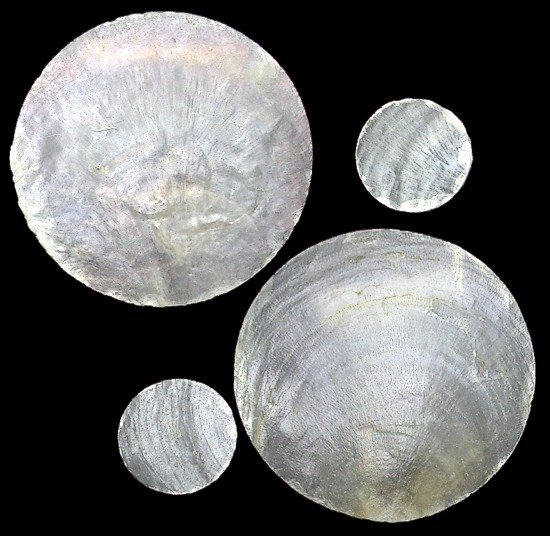
CAPIZ SHELL ROUNDS WITH NO HOLE
M1-12
Twelve round Capiz shells, measuring 1 inch in diameter, without a hole...... $5.65
M5-12
Twelve Capiz shell rounds, 1.5 inches in diameter, without a hole...... $6.29
M55-12
Three Capiz shell rounds, 1.5 inches in diameter, without a hole...... $5.75
M555-12
Twenty five Capiz shell rounds, 1.5 inches in diameter, without a hole...... $8.85
M5555-12
Fifty Capiz shell rounds, 1.5 inches in diameter, without a hole...... $12.35
M55555-12
One hundred Capiz shell rounds, 1.5 inches in diameter, without a hole...... $19.35
M2-12
Twelve Capiz shell rounds without a hole, measuring 2 inches in diameter....... $6.65
M22-12
Three Capiz shell rounds without a hole, measuring 2 inches in diameter....... $4.99
M222-12
Twenty five Capiz shell rounds without a hole, measuring 2 inches in diameter....... $9.58
M2222-12
Fifty Capiz shell rounds without a hole, measuring 2 inches in diameter....... $13.85
M22222-12
One hundred Capiz shell rounds without a hole, measuring 2 inches in diameter....... $22.35
M4-12
Twelve Capiz round shells without a hole, measuring 2.5 inches..... $7.35
M44-12
Three Capiz round shells without a hole, measuring 2.5 inches..... $5.99
M444-12
Twenty five Capiz round shells without a hole, measuring 2.5 inches..... $11
M4444-12
Fifty Capiz round shells without a hole, measuring 2.5 inches..... $16.85
M44444-12
One hundred Capiz round shells without a hole, measuring 2.5 inches..... $28.35
M3-12
Twelve 3-inch Capiz Rounds Without a Hole....... $7.49
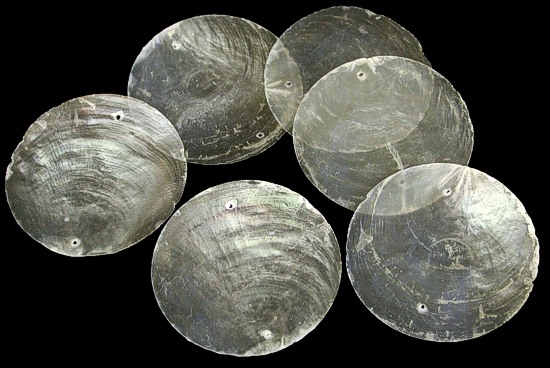
CAPIZ ONE HOLE
S1-34
Twelve round Capiz shells with a single hole, measuring 2.5 inches in diameter....... $6.65
S11-34
Three round Capiz shells with a single hole, measuring 2.5 inches in diameter....... $5.85
S111-34
Twenty five round Capiz shells with a single hole, measuring 2.5 inches in diameter....... $9.59
S1111-34
Fifty round Capiz shells with a single hole, measuring 2.5 inches in diameter....... $13.85
S11111-34
One hundred round Capiz shells with a single hole, measuring 2.5 inches in diameter....... $22.35
S2-34
Twelve Capiz Rounds With One Hole measuring 2 inches...... $6.15
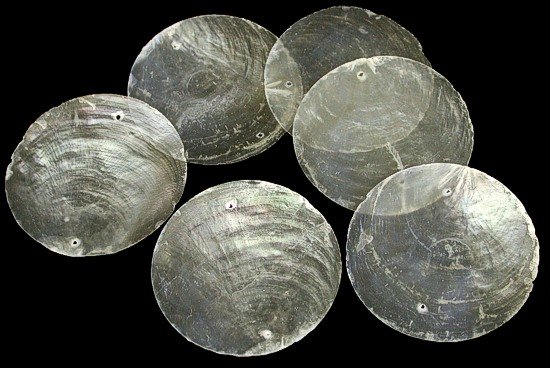
CAPIZ ROUND TWO HOLE
O1-34
Twelve Capiz shell rounds with two holes, measuring 2.5 inches in diameter...... $5.59
O11-34
Three Capiz shell rounds with two holes, measuring 2.5 inches in diameter...... $4.59
O111-34
Twenty five Capiz shell rounds with two holes, measuring 2.5 inches in diameter...... $7.85
O1111-34
Fifty Capiz shell rounds with two holes, measuring 2.5 inches in diameter...... $10.35
O11111-34
One hundred Capiz shell rounds with two holes, measuring 2.5 inches in diameter...... $15.35
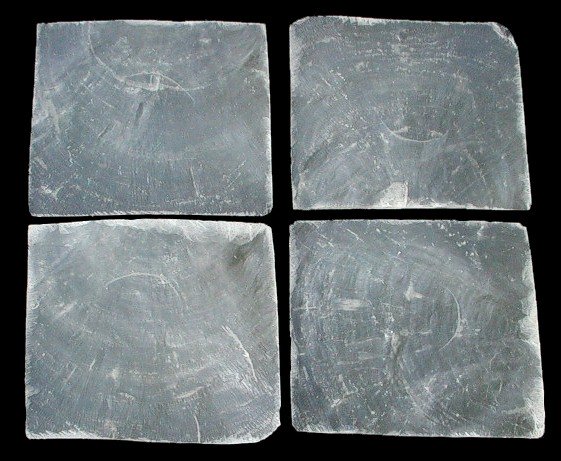
CAPIZ SQUARE NO HOLE
L1-34
Twelve Capiz shells, square-shaped without a hole, measuring 2x2 inches...... $6.65
L11-34
Three Capiz shells, square-shaped without a hole, measuring 2x2 inches...... $4.99
L111-34
Twenty five Capiz shells, square-shaped without a hole, measuring 2x2 inches...... $9.59
L1111-34
Fifty Capiz shells, square-shaped without a hole, measuring 2x2 inches...... $13.85
L11111-34
One hundred Capiz shells, square-shaped without a hole, measuring 2x2 inches...... $22.30
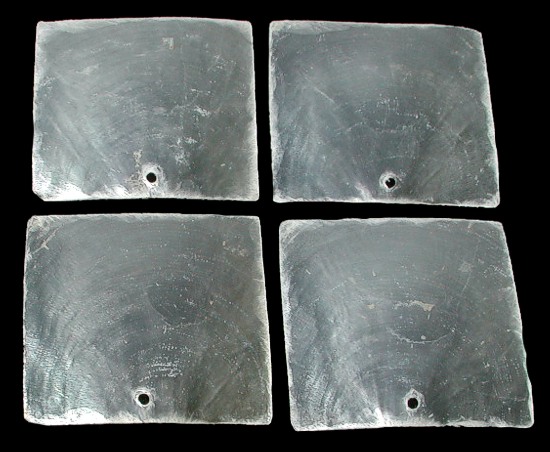
CAPIZ SQUARE ONE HOLE
M1-34
Twelve square Capiz shells with a single hole, measuring 2x2 inches...... $5.79
M11-34
Three square Capiz shells with a single hole, measuring 2x2 inches...... $4.89
M111-34
Twenty five square Capiz shells with a single hole, measuring 2x2 inches...... $7.85
M1111-34
Fifty square Capiz shells with a single hole, measuring 2x2 inches...... $10.35
M11111-34
One hundred square Capiz shells with a single hole, measuring 2x2 inches...... $15.35
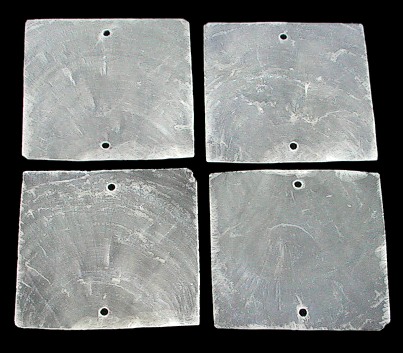
ONE CAPIZ SQUARE TWO HOLE
J1-34
Twelve square Capiz shells with two holes, measuring 2x2 inches...... $6.29
J11-34
Three square Capiz shells with two holes, measuring 2x2 inches...... $4.99
J111-34
Twenty five square Capiz shells with two holes, measuring 2x2 inches...... $8.85
J1111-34
Fifty square Capiz shells with two holes, measuring 2x2 inches...... $12.35
J11111-34
One hundred square Capiz shells with two holes, measuring 2x2 inches...... $19.35
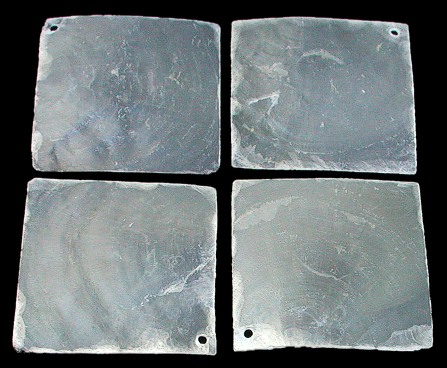
CAPIZ DIAMOND ONE HOLE
I1-34
Twelve Capiz diamonds with a hole, measuring 2x2 inches....... $6.65
I11-34
Three Capiz diamonds with a hole, measuring 2x2 inches....... $5.85
I111-34
Twenty five Capiz diamonds with a hole, measuring 2x2 inches....... $9.59
I1111-34
Fifty Capiz diamonds with a hole, measuring 2x2 inches....... $13.85
I11111-34
One hundred Capiz diamonds with a hole, measuring 2x2 inches....... $22.35
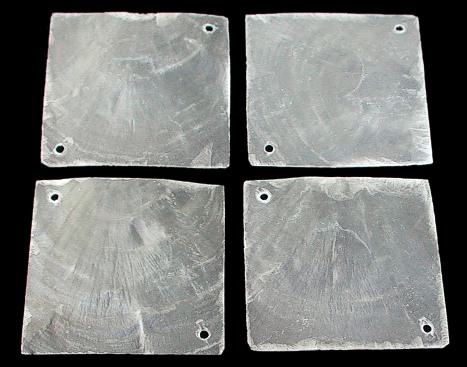
CAPIZ DIAMOND TWO HOLES
H1-34
Twelve Capiz Diamonds With Two Holes measuring 2x2 inches...... $6.65
H11-34
Three Capiz Diamonds With Two Holes measuring 2x2 inches...... $4.99
H111-34
Twenty five Capiz Diamonds With Two Holes measuring 2x2 inches...... $9.59
H1111-34
Fifty Capiz Diamonds With Two Holes measuring 2x2 inches...... $13.85
H11111-34
One hundred Capiz Diamonds With Two Holes measuring 2x2 inches...... $22.35
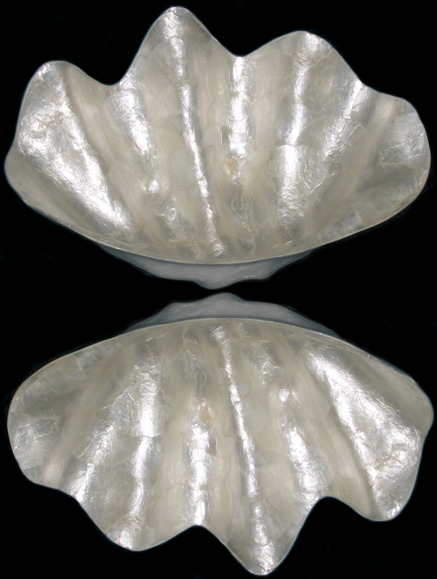
CAPIZ CLAM DISH
Capiz items are not washable, but they can be wiped with a damp towel.
GC1-90
One 8 1/2 Inch Capiz Clam Dish.....OUT OF STOCK
GC2-90
One 10 1/2 Inch Capiz Clam Dish.....OUT OF STOCK
GC3-90
One 12 1/2 Inch Capiz Clam Dish.....OUT OF STOCK
GC4-90
One Capiz Clam Dish measuring 16.5 inches......OUT OF STOCK
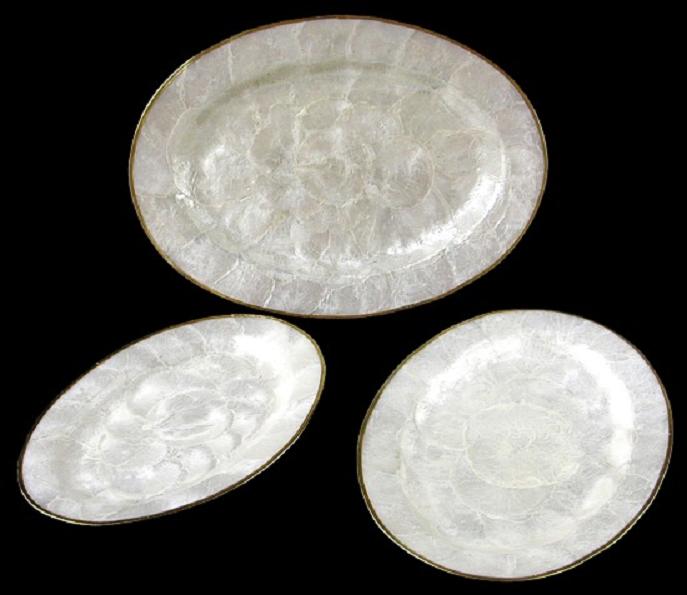
THREE PIECE CAPIZ GOLD TRIM OVALS
These are not washable but can be wiped with a damp towel.
EE1-90
Three Piece Capiz Gold Trim Oval, graduated size, largest size 11 1/2 x 8 1/2 inches (picture provides good example of size differential)..... $23.50
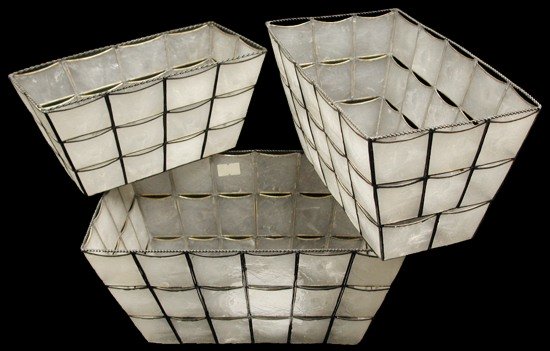
Three Piece Capiz Rectangle Basket Set graduated size
Not washable but can be wiped with a damp towel.
MM1-90
Three-Piece Capiz Rectangle Basket Set, 10 x 6 inches, featuring graduated sizes (as illustrated by the picture for size comparison)......... $27.50
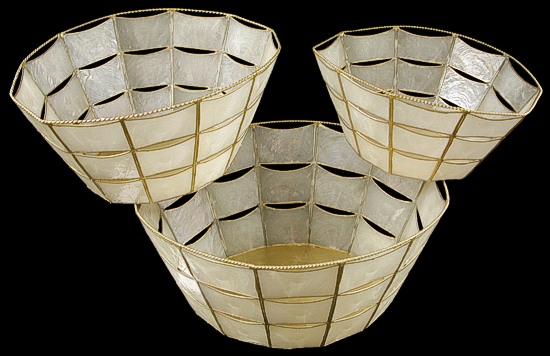
Three Piece Capiz Oval Baskets Set graduated size
Not washable but can be wiped with a damp towel.
NN1-90
Three-Piece Capiz Oval Basket Set, 10 x 5 inches, with graduated sizes (the picture provides a good example of the size differential)....... $26.75